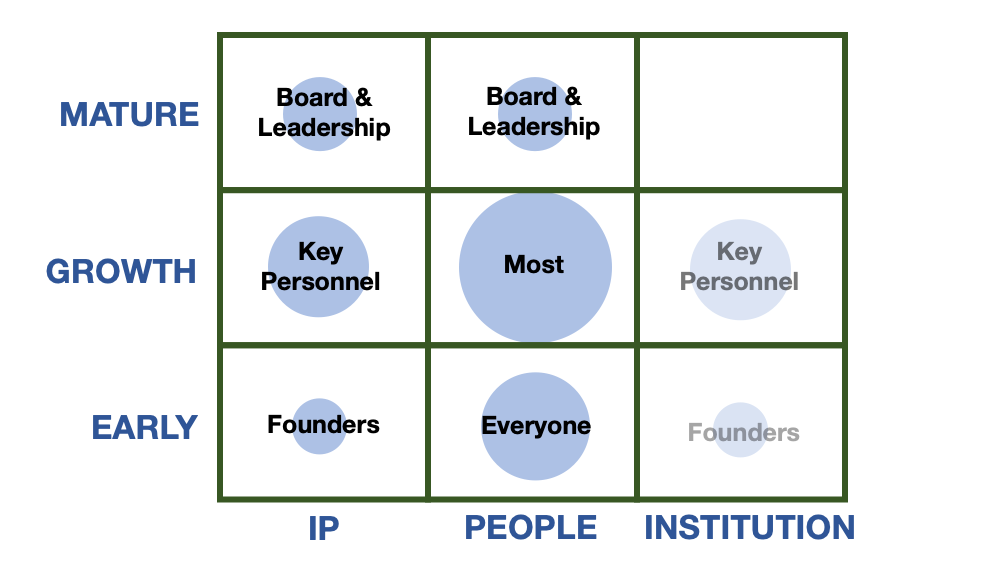
To Team or Not to Team
It can feel like an afterthought, but every website rebuild project at some point comes around to the question on the Team or About Us page: do we include photos of the team, and if so, which ones? Should we have individual portraits or a group shot?
Here’s how to think about it.
Descriptions and photos of your team can be an integral part of the story you’re telling about your startup. Star individual employees (or advisors) can impress. Employee count is a common proxy for success. But depending on the startup, I sometimes advise against including the team at all.
I’ve usually made this decision by instinct but this weekend I sat down to determine the structure behind my thinking. It comes down to the type of business, and to the stage. The categories and stages are somewhat vague and fluid, but I hope it is a valuable starting point as you clarify your own situation. The size and darkness of the circles are approximate indications of the emphasis given to the team in the website layout, and the number of team members to include.
IP: Founders are a key aspect of companies that are built around intellectual property (life sciences, deep tech etc), like many of the companies coming out of universities. The founders are often impressive and validate gravitas. I recommend bragging about the founders and advisors. Expand the team descriptions into the growth phase, but no need to include every employee. When you get big, including top personnel is usually a good idea.
Examples from my clients and beyond:
IP Early: OnCusp. https://www.oncusptx.com/aboutus/index.html#manageteam
IP Growth: Precision Neuroscience. A twist on the typical solution: key researcher highlighted, then group shot and link to LinkedIn team list. https://precisionneuro.io/about
IP Mature: Genentech: https://www.gene.com/about-us/leadership
People: Businesses that depend on teams to be successful (SaaS, Consulting, any business where clients get assigned account reps and where service is a key aspect of the business proposition) should feature their people. Including the interns and assistants in the team descriptions makes sense through growth phase. Even mature businesses in this sector are still about people, and should include key personnel.
People Early: Prelude: https://www.prelude.pro/about
People Growth: Web3Pro: https://www.web3pro.com/about-us/
People Mature: McCann New York. https://www.mccannny.com/about
Institutions: I find this most commonly in fintech, but other verticals have examples as well. These are companies where success represents becoming a monolith. I understand that Bank of America has people running it, but as a customer I don’t care who, and in fact I’d almost rather not know. It’s like when I board an airplane, there’s something disconcerting about meeting the pilots or seeing the inside of the cockpit. It makes it seem human and frail. I want to think of the airplane as this thing that is simply preordained to take off and land, not that it’s being controlled by a couple of people in a cramped space who maybe are hung over, can get distracted, or misread the dials. Institutions, and startups aiming to become institutions, might want to include founders if they’re particularly impressive, but otherwise I’d skip it. During the growth phase photos of the team might convey success, but then I’d strip them off again.
Institution Early: Jia Finance. https://jiafinance.com/about
Institution Growth: Figure Technologies (no team): https://www.figure.com/
Institution Mature: Stripe (no team): https://stripe.com/
Some additional points:
- Portraits. Make your individual portraits consistent. If you can get one photographer to do them in the same style and against a similar background, great, but know that as you hire you’ll need to photograph everyone the same way. Easier is to keep the portraits similar and then use Photoshop to make the backgrounds match—for example make them all white, or complementary primary colors. Trifecta Nutrition is a great example of expressing personality and making the team feel cohesive across individual photos. https://www.trifectanutrition.com/our-story
- Group Photographs. Group shots are great, but only as a design element to illustrate the collective. Don’t use a group shot to show everyone at the company. In terms of people it will be out of date within six months, if not six days. But it shows more powerfully than anything else that you are in fact a team. Or at least got together, once, which took planning and money, which by itself indicates commitment.
- Investors: Whether to include investor logos is a similar decision. For a while it lends credence, but at some point their importance—and even the idea that the company needs investors to be around—fades into negative territory.
Let me know if you have a startup or situation outside of my categories, or if you have seen a particularly impressive or creative approach to presenting a team on a company website!
Let’s Build,
Otto
Otto Pohl is a communications consultant who helps startups tell their story better. He works with deep tech, health tech, and climate tech leaders looking to create profound impact with customers, partners, and investors. He has taught entrepreneurial storytelling at USC Annenberg and at accelerators across the country. Learn more at www.corecommunicationsconsulting.com

